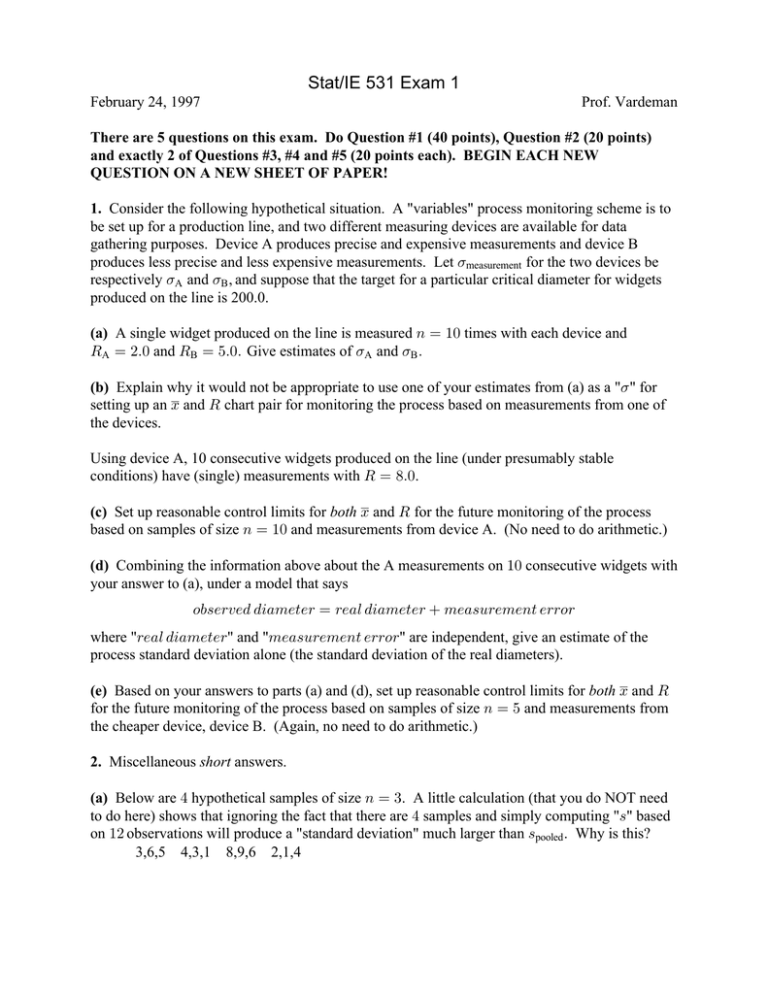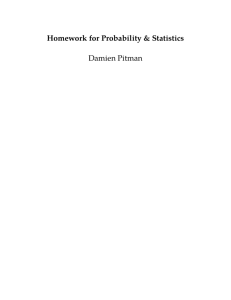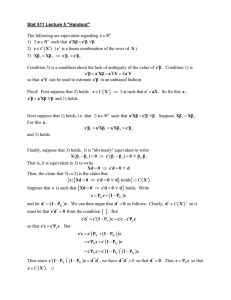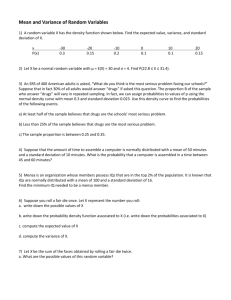Stat/IE 531 Exam 1
advertisement

Stat/IE 531 Exam 1
February 24, 1997
Prof. Vardeman
There are 5 questions on this exam. Do Question #1 (40 points), Question #2 (20 points)
and exactly 2 of Questions #3, #4 and #5 (20 points each). BEGIN EACH NEW
QUESTION ON A NEW SHEET OF PAPER!
1. Consider the following hypothetical situation. A "variables" process monitoring scheme is to
be set up for a production line, and two different measuring devices are available for data
gathering purposes. Device A produces precise and expensive measurements and device B
produces less precise and less expensive measurements. Let 5measurement for the two devices be
respectively 5A and 5B , and suppose that the target for a particular critical diameter for widgets
produced on the line is 200.0.
(a) A single widget produced on the line is measured 8 œ "! times with each device and
VA œ #Þ! and VB œ &Þ!Þ Give estimates of 5A and 5B Þ
(b) Explain why it would not be appropriate to use one of your estimates from (a) as a "5" for
– and V chart pair for monitoring the process based on measurements from one of
setting up an B
the devices.
Using device A, 10 consecutive widgets produced on the line (under presumably stable
conditions) have (single) measurements with V œ )Þ!.
– and V for the future monitoring of the process
(c) Set up reasonable control limits for both B
based on samples of size 8 œ "! and measurements from device A. (No need to do arithmetic.)
(d) Combining the information above about the A measurements on "! consecutive widgets with
your answer to (a), under a model that says
9,=/<@/. .3+7/>/< œ </+6 .3+7/>/< € 7/+=?</7/8> /<<9<
where "</+6 .3+7/>/<" and "7/+=?</7/8> /<<9<" are independent, give an estimate of the
process standard deviation alone (the standard deviation of the real diameters).
– and V
(e) Based on your answers to parts (a) and (d), set up reasonable control limits for both B
for the future monitoring of the process based on samples of size 8 œ & and measurements from
the cheaper device, device B. (Again, no need to do arithmetic.)
2. Miscellaneous short answers.
(a) Below are % hypothetical samples of size 8 œ $. A little calculation (that you do NOT need
to do here) shows that ignoring the fact that there are % samples and simply computing "=" based
on "# observations will produce a "standard deviation" much larger than =pooled . Why is this?
3,6,5 4,3,1 8,9,6 2,1,4
(b) What do multivariate control charts provide that is not available in separate monitoring of :
quality dimensions?
(c) It is often helpful to state "standard errors" (estimated standard deviations) corresponding to
point estimates of quantities of interest. In a context where a standard deviation, 5, is to be
–
estimated by VÎ.# Ð8Ñ based on < samples of size 8, what is a reasonable standard error to
announce? (Be sure that your answer is computable from sample data, i.e. doesn't involve any
unknown process parameters.)
Choose only 2 of Questions #3, #4 and #5.
3. In applying ANOVA methods to gage R&R studies, one often uses linear combinations of
independent mean squares as estimators of their expected values. In fact, it is possible to also
produce standard errors (estimated standard deviations) for these linear combinations.
Suppose that Q W" ß Q W# ß ÞÞÞß Q W5 are independent random variables,
random variable
/ 3 Q W3
E Q W3
µ ;#/3 Þ Consider the
P œ -" Q W" € -# Q W# € â € -5 Q W5 .
(a) Find the standard deviation of PÞ
(b) Your expression from (a) should involve the means EQ W3 , that in applications will be
unknown. Propose a sensible (data-based) estimator of the standard deviation of P that does not
involve these quantities.
(c) Apply your result from (b) to give a sensible standard error for the ANOVA-based estimator
2
of 5overall
.
4. In class, Vardeman considered a "two alarm rule monitoring scheme" due to Wetherill and
showed how find the ARL for that scheme by solving two linear equations for quantities P and
P‡ . It is possible to extend the arguments presented in class and find the variance of the run
length.
(a) For a generic random variable \ , express both Var\ and EÐ\ € "Ñ# in terms of E\ and
E\ # .
(b) Let Q be the expected square of the run length for the Wetherill scheme and let Q ‡ be the
expected square of the number of additional plotted points required to produce an out of control
signal if there has been no signal to date and the current plotted point is in region B. Set up two
equations for Q and Q ‡ that are linear in Q , Q ‡ ß P and P‡ .
(c) The equations from (b) can be solved simultaneously for Q and Q ‡ . Do not take time to
solve therm here, but express the variance of the run length for the Wetherill scheme in terms of
Q , Q ‡ ß P and P‡ .
5. In class Vardeman presented "rounded data" likelihood methods for normal data with the 2
parameters . and 5. The same kind of thing can be done for other families of distributions
(which can have other numbers of parameters). For example, the exponential distributions with
means )•" can be used. (Here there is the single parameter ).) These exponential distributions
have cdf's
J) ÐBÑ œ œ
" • expÐ • )BÑ
!
for B !
for B • ! .
Below is a frequency table for twenty exponential observations that have been rounded to the
nearest integer.
rounded value 0 1 2 3 4
frequency
7 8 2 2 1
(a) Write out an expression for the appropriate "rounded data log likelihood function" for this
problem,
_Ð)Ñ œ log PÐ.+>+l )Ñ Þ
(You should be slightly careful here. Exponential random variables only take values in the
interval Ð!ß_Ñ .)
(b) Attached to this exam is a plot of _Ð)Ñ. Use it and identify the maximum likelihood estimate
of ) based on the rounded data.
(c) Use the attached plot and make an approximate 90% confidence interval for ). (The
appropriate ;# value has 1 associated degree of freedom.)
Stat/IE 531 Exam 2
April 9, 1997
Prof. Vardeman
Do Both of Problems 1 and 2
1. Suppose that standard values of process parameters are . œ "( and 5 œ #Þ%.
– based on samples of size 8 œ %ß design either a combined high and
(a) Using sample means B
low side CUSUM scheme (with 0 headstarts) or a EWMA scheme to have an "all ok" ARL of
$(! and quickest possible detection of a shift in process of mean of size Þ'.
(b) If, in fact, the process mean is . œ "(Þ& and the process standard deviation is 5 œ $Þ!, show
how you would find the ARL associated with your scheme from (a). (You don't need to actually
interpolate in any table, but DO compute the values you would need in order to enter a table, and
say which table you must employ.)
2. A discrete variable \ can take only values "ß #ß $ß % and &. Nevertheless, managers decide to
"monitor process spread" using the range of samples of size 8 œ #. Suppose, for sake of
argument, that under standard plant conditions observations are iid and uniform on the values "
through & (i.e. T Ò\ œ "Ó œ T Ò\ œ #Ó œ T Ò\ œ $Ó œ T Ò\ œ %Ó œ T Ò\ œ &Ó œ Þ#).
(a) Find the distribution of V for this situation. (Note that V has possible values !ß "ß #ß $ and %.
You need to reason out the corresponding probabilities.)
(b) The correct answer to part (a) has EV œ "Þ'. This implies that if many samples of size
–
8 œ # are taken and V computed, one can expect a mean range near "Þ'. Find and criticize
corresponding normal theory control limits for V .
(c) Suppose that instead of using a normal-based Shewhart chart for V , one decides to use a high
side Shewhart-CUSUM scheme with reference value 5" œ # and starting value !, that signals the
first time any range is % or that the CUSUM is $ or more. Use your answer for (a) and show how
to find the ARL for this scheme. (You need not actually carry through the calculations, but show
explicitly how to set things up.)
(If you were unable to do part (a), complete part (c) using the (wrong) distribution for V , given
by 0 Ð!Ñ œ Þ"&ß 0 Ð"Ñ œ Þ#ß 0 Ð#Ñ œ Þ$ß 0 Ð$Ñ œ Þ#& and 0 Ð%Ñ œ Þ".)
Do Only 2 of Problems 3, 4 and 5
(if you choose 5, do only 5A or 5B, not both)
3. A process has a "good" state and a "bad" state. Suppose that when in the good state, the
probability that an observation on the process plots outside of control limits is 1, while the
corresponding probability for the bad state is ,. Assume further that if the process is in the good
state at time > • ", there is a probability . of degradation to the bad state before an observation at
time > is made. (Once the process moves into the bad state it stays there until that condition is
detected via process monitoring and corrected.)
Find the "ARL"/mean time of alarm, if the process is in the good state at time > œ ! and
observation starts at time > œ "Þ
4. Consider the following (nonstandard) process monitoring scheme for a variable \ that has
ideal value 0. Suppose 2ÐBÑ ž ! is a function with 2ÐBÑ œ 2Ð • BÑ that is decreasing in lBl. (2
has its maximum at ! and decreases symmetrically as one moves away from !Þ) Then suppose
that
i) control limits for \" are „ 2Ð!Ñ, and
ii) for > ž " control limits for \> are „ 2Ð\>•" ÑÞ
(Control limits vary. The larger that l\>•" l is, the tighter are the limits on \> .)
Discuss how you would find an ARL for this scheme for iid \ with marginal probability density
0 . (Write down an appropriate integral equation, briefly discuss how you would go about solving
it and what you would do with the solution in order to find the desired ARL.)
5A. Suppose that a model Y implies that
EY Ò^Ð> € "Ñl^ > Ó œ
"
^Ð>Ñ
#
while
EY Ò^Ð=Ñl^ > Ó œ ! for =
>€# Þ
(I'm not sure that there is any such model, but ingore this worry for the purposes of this problem.)
If X Ð>Ñ » ! find optimal (MV) control strategies for two different situtations involving numerical
process adjustments +.
(a) First suppose that EÐ+ß =Ñ œ + for all = "
(b) Then suppose the impact of a control action is similar to that in (a), except there is
one period of delay, i.e.
EÐ+ß =Ñ œ œ
+
!
for = #
for = œ "
5B. Attached are two tables giving some values of an uncontrolled process ^Ð>Ñ that has target
X Ð>Ñ » !. Suppose that a manipulated variable \ is available and that the simple (integral only)
control algorithm
?\Ð>Ñ œ IÐ>Ñ
will be employed, based on an observed process ] Ð>Ñ that is the sum of ^Ð>Ñ and the effects of
all relevant changes in \ .
Consider two different scenarios:
(a) a change of ?\ in the manipulated variable impacts all subsequent values of ] Ð>Ñ
by the addition of an amount ?\ , and
(b) there is one period of dead time, after which a change of ?\ in the manipulated
variable impacts all subsequent values of ] Ð>Ñ by the addition of an amount ?\Þ
Fill in the two tables according to these two scenarios and then comment on the lesson they
seem to suggest about the impact of dead time on the effectiveness of PID control.
Problem 5B Scenario (a) (no dead time)
>
^Ð>Ñ
X Ð>Ñ
] Ð>Ñ
!
•"
!
•"
"
•"
!
#
•"
!
$
•"
!
%
•"
!
&
•"
!
'
•"
!
(
•"
!
)
•"
!
*
•"
!
IÐ>Ñ œ ?\Ð>Ñ
Problem 5B Scenario (b) (one period of dead time)
>
^Ð>Ñ
X Ð>Ñ
] Ð>Ñ
!
•"
!
•"
"
•"
!
#
•"
!
$
•"
!
%
•"
!
&
•"
!
'
•"
!
(
•"
!
)
•"
!
*
•"
!
IÐ>Ñ œ ?\Ð>Ñ
Stat/IE 531 Final Exam
May 6, 1997
Prof. Vardeman
1. In their article "Robust Design Through Optimization Techniques," that appeared in Quality
Engineering in 1994, Lawson and Madrigal modeled an impedance (^ ) in a thin film
redistribution layer as
^ œ %"Þ! ‚ lnŒ
&Þ*)E
•
Þ)!F € G
where E is an insulator thickness, F is a line width and G is the line height. Suppose that in
manufactured circuits, means and standard deviations of the variables E, F and G are
respectively .E œ #&ß 5E œ Þ$$$$ß .F œ "&ß 5F œ Þ####ß .G œ & and 5G œ Þ"""". (The units
of E, F and G are all "!•' m, but the article neglects to state the units of ^ .)
(a) Find an approximate mean and standard deviation to associate with ^ in the design of these
devices.
(b) Manufacturing variation on which of the variables E, F or G is predicted to be the largest
contributor to variation in impedance ^ ? Explain.
2. Suppose that on M œ # different days (A), N œ % different heats (B) of cast iron are studied,
with 7 œ $ tests (C) being made on each. Suppose further that the resulting percent carbon
measurements produce WWE œ Þ!$&&ß WWFÐEÑ œ Þ!!)" and WWGÐFÐEÑÑ œ WWI œ Þ%!))Þ
(a) If one completely ignores the hierarchical structure of the data set, what "sample variance"
is produced? Does this quantity estimate the variance that would be produced if on many
different days a single heat was selected and a single test made? Explain carefully! (Find the
expected value of the grand sample variance under the hierarchical random effects model and
compare it to this variance of single measurements made on a single day.)
(b) Give point estimates of the variance components 5!# ß 5"# and 5# .
(c) Your estimate of 5!# should involve a linear combination of mean squares. Give the variance
of that linear combination in terms of the model parameters and Mß N and 7Þ Use that expression
and propose a sensible estimated standard deviation (a standard error) for this linear
combinationÞ
3. Individual items produced on a manufacturer's line may be graded as "Good" (G), "Marginal"
(M) or "Defective" (D). Under stable process conditions, each successive item is (independently)
G with probability :G, M with probability :M and D with probability :D , where
:G € :M € :D œ ". Suppose that ultimately, defective items cause three times as much extra
expense as marginal ones.
Based on the kind of cost information alluded to above, one might give each inspected item a
"score" = according to
Ú$
=œÛ "
Ü!
if the item is D
if the item is M
if the item is G .
It is possible to argue (don't bother to do so here) that EÐ=Ñ œ $:D € :M and
VarÐ=Ñ œ *:D Ð" • :D Ñ € :M Ð" • :M Ñ • $:D :M .
Process Monitoring
(a) Give formulas for standards given Shewhart control limits for average scores –= based on
samples of size 8. Describe how you would obtain the information necessary to calculate limits
for future control of –=.
(b) Ultimately, suppose that "standard" values are set at :G œ Þ*!, :M œ Þ!( and :D œ Þ!$ and
8 œ "!! is used for samples of a high volume product. Use a normal approximation to the
distribution of –= and find an approximate ARL for your scheme from part (a) if in fact the mix of
items shifts to where :G œ Þ)&ß :M œ Þ"! and :D œ Þ!&.
(c) Suppose that one decides to use a high side CUSUM scheme to monitor individual scores as
they come in one at a time. Consider a scheme with 5" œ " and no head-start that signals the
first time that a CUSUM of scores of at least 2" œ ' is reached. Set up an appropriate transition
matrix and say how you would use that matrix to find an ARL for this scheme for an arbitrary set
of probabilities Ð:Gß :M ß :D Ñ.
Acceptance Sampling
(d) Suppose that inspecting an item costs "/&th of the extra expense caused by an undetected
marginal item. A plausible (single sampling) acceptance sampling plan for lots of R =10,000 of
these items then accepts the lot if
–= Ÿ Þ#! Þ
If rejection of the lot will result in 100% inspection of the remainder, consider the ("perspective
B") economic choice of sample size for plans of this form, in particular the comparison of
8 œ "!! and 8 œ %!! plans. The following table gives some approximate acceptance
probabilities for these plans under two sets of probabilities : œ Ð:Gß :M ß :D Ñ.
8 œ "!!
8 œ %!!
: œ ÐÞ*ß Þ!(ß Þ!$Ñ
T + ¸ Þ('
T + ¸ Þ*#
: œ ÐÞ)&ß Þ"!ß Þ!&Ñ
T + ¸ Þ#%
T + ¸ Þ!)
Find expected costs for these two plans (8 œ "!! and 8 œ %!!Ñ if costs are accrued on a per
item and per inspection basis and "prior" probabilities of these two sets of process conditions are
respectively Þ) for : œ ÐÞ*ß Þ!(ß Þ!$Ñ and Þ# for : œ ÐÞ)&ß Þ"!ß Þ!&Ñ.
4. Consider the classical problem of acceptance sampling plan design. Suppose that one wants
plans whose OC "drops" near : œ Þ!$ (wants T + ¸ Þ& for : œ Þ!$Ñ also wants : œ Þ!% to have
T + ¸ Þ!&Þ
(a) Design an attributes single sampling plan approximately meeting the above criteria.
Suppose that in fact "nonconforming" is defined in terms of a measured variable, \ , being less
than a lower specification P œ "$, and that it is sensible to use a normal model for \ .
(b) Design a "known 5" variables plan for the above criteria if 5 œ "Þ
(c) Design an "unknown 5" variables plan for the above criteria.
5. Miscellaneous Short Answer
(a) A single operator measures a single widget diameter "& times and obtains a range of
V œ $ ‚ "!•% inches. Then this person measures the diameters of "# different widgets once
each and obtains a range of V œ ) ‚ "!•% inches. Give an estimated standard deviation of
widget diameters (not including measurement error).
(b) Confidence intervals for ., prediction intervals and tolerance intervals do different jobs.
What are these different jobs?
(c) SQC novices faced with the task of analyzing a sequence of (say) 7 individual observations
– " and "=" from the 7 data values and
collected over time often do the following: Compute "B
– „ $= to the 7 individuals. Say why this method of operation is
apply "control limits" B
essentially useless.
(d) Attached is a photocopy of a corporate "capability analysis" form. Reading from this form,
what do you estimate to be the mean and standard deviation of thread lengths of this type (in Þ!!"
inch over nominal)?





